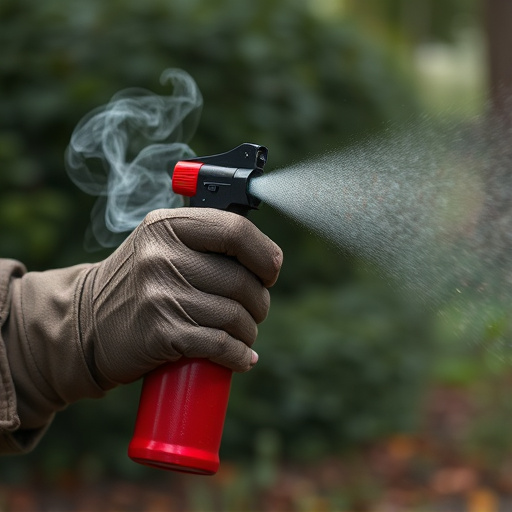Bear spray, a powerful tool for hikers in bear country, uses capsaicin to deter and drive off aggressive bears within a 20-30 foot range. Effective but should be a last resort; proper training essential. Choose sprays with higher pepper concentrations and wider ranges tailored to specific wildlife encounters. Master usage techniques: stand at an angle, activate spray swiftly towards face or eyes. Be aware that success varies based on distance, wind, bear motivation; have backup strategies like noise, objects, retreating, or playing dead if needed.
Bear encounters can be frightening, but understanding defensive pepper spray mechanics and its effective range can provide valuable protection. This article delves into the world of bear spray defense, guiding you through crucial aspects like choosing the right pepper spray for wildlife encounters and mastering correct usage techniques to maximize defensive distances. We’ll also explore real-world scenarios where bear spray may fail, offering alternatives for enhanced safety in unpredictable environments.
- Understanding Bear Spray Mechanics and Effective Range
- Choosing the Right Pepper Spray for Wildlife Encounters
- Correct Usage Techniques to Maximize Defense Distance
- Real-World Scenarios: When Bear Spray Fails and Alternatives
Understanding Bear Spray Mechanics and Effective Range
Bear spray, also known as defensive pepper spray, is a powerful tool for deterring aggressive bears during encounters in wild environments. Understanding its mechanics and effective range is crucial for hikers, campers, and anyone venturing into bear country. When used correctly, bear spray creates a cloud of capsaicin-laced solution that irritates the bear’s eyes, nose, and respiratory system, causing it to flee.
The defensive pepper spray distance range varies depending on factors like the user’s movement, wind conditions, and the sprayer’s quality. Typically, effective deterrence occurs within a 30-foot (or approximately 9-meter) radius. It’s important to remember that bear spray is not a cure-all; it works best as a last line of defense when an encounter becomes unavoidable. Proper training in its use and awareness of local guidelines for carrying and deploying bear spray are essential components of bear safety protocols.
Choosing the Right Pepper Spray for Wildlife Encounters
When preparing for potential wildlife encounters, selecting the appropriate defensive pepper spray is key. Look for a spray designed specifically for animal deterrence, as these typically have higher pepper concentrations and wider defensive pepper spray distance ranges. This ensures maximum impact if an attack occurs.
Consider factors like the type of animals you’re most likely to face and their typical behavior. Some sprays are formulated to be more effective against larger predators, while others may specialize in repelling smaller, more agile species. Additionally, check the manufacturer’s recommendations on spray distance, ensuring it’s suitable for closing the gap between you and potential threats quickly and safely.
Correct Usage Techniques to Maximize Defense Distance
Mastering the correct usage techniques is paramount when employing bear spray as a defense mechanism, as it directly impacts the defensive pepper spray distance range. To maximize its effectiveness, users must adhere to specific guidelines. Firstly, ensure proper positioning by standing at an angle away from the approaching animal, allowing for a clear line of sight. Secondly, activate the spray with a swift, firm motion, releasing the nozzle towards the target’s face or eyes, which are sensitive areas. The ideal defensive pepper spray distance range is approximately 20-30 feet (6-9 meters), creating a barrier that can provide crucial seconds to escape or deter an attack.
Practicing these techniques in simulated scenarios can significantly improve response time and accuracy. Users should aim for the animal’s eyes, nose, and mouth, areas that will be most affected by the spray, temporarily blinding and disorienting it. Remember, bear spray is a tool meant to buy time; always stay alert and prepared to take evasive action if needed, even after deploying the spray.
Real-World Scenarios: When Bear Spray Fails and Alternatives
In real-world scenarios, even the most effective defensive pepper spray isn’t foolproof. Bear attacks can vary greatly in intensity and behavior, leading to instances where bear spray fails to deter or stop an attack. Factors like distance, wind direction, and the bear’s hunger or protectiveness can impact the spray’s effectiveness. For instance, if the spray blows back due to the wind or doesn’t reach the bear within the recommended defensive pepper spray distance range (typically 20-30 feet), it may not provide adequate protection.
When bear spray fails, individuals must rely on alternative strategies for self-defense. This includes making loud noises, throwing objects, or trying to back away slowly while maintaining eye contact with the bear. In extreme cases, playing dead as a last resort can help avoid aggressive attacks. It’s crucial to be prepared and understand that different tactics may be required based on the situation, location, and bear behavior encountered in the wild.
Bear spray can be an effective tool in defending against animal attacks, but understanding its mechanics, choosing the right product, and mastering usage techniques are crucial for maximizing its defensive distance. While no single solution guarantees protection in every scenario, the proper use of defensive pepper spray, combined with awareness and avoidance strategies, can significantly enhance safety during wildlife encounters. Remember, knowledge is key; being prepared can make all the difference.
